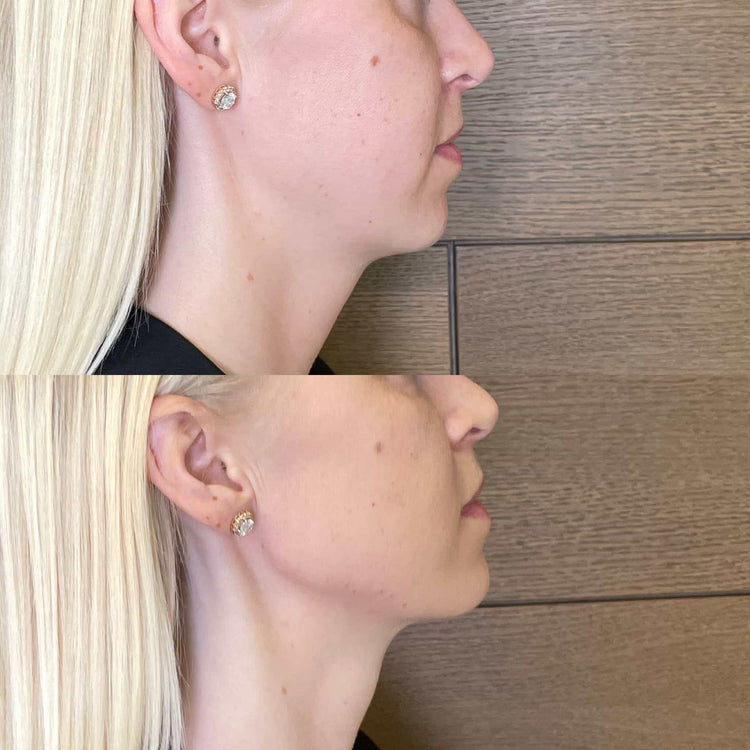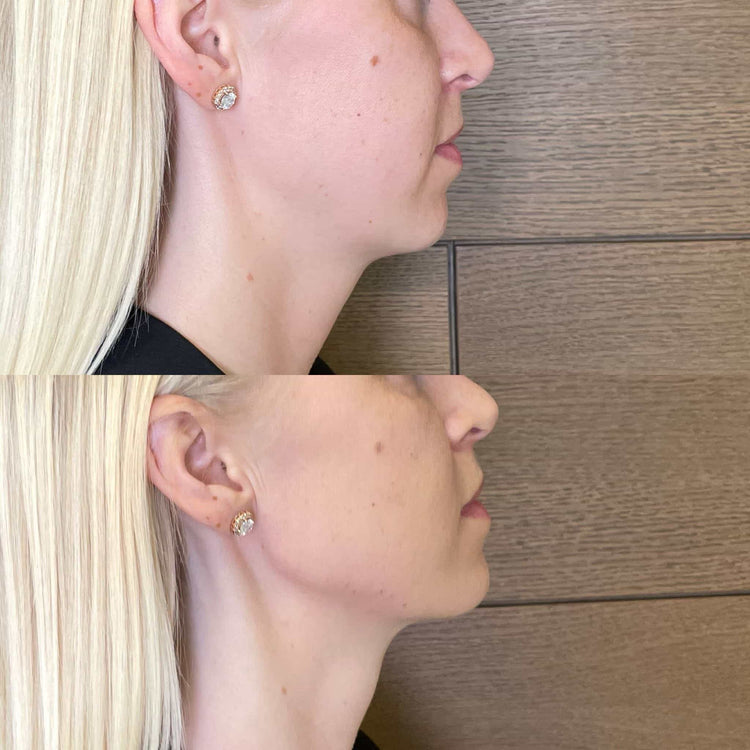Potential Complications
While jaw fillers can offer a dramatic enhancement to facial features, it is essential to understand the potential complications associated with this procedure. Like any medical intervention, jaw filler injections carry inherent risks that can range from mild discomfort to more serious adverse reactions.
Bruising and Swelling
One common complication after jaw filler treatment is bruising and swelling. This is a normal part of the healing process and usually subsides within a few days to a week. However, in some cases, bruising and swelling may persist longer or be more severe.
Other potential complications include infection, allergic reactions, and migration of the filler material. It’s important to consult with a qualified and experienced practitioner to minimize the risk of complications and ensure safe and effective treatment.
Infection
Infection is one potential complication associated with jaw fillers. The introduction of any foreign substance into the body carries a risk of infection. Signs of infection may include redness, swelling, pain, warmth, or discharge at the injection site. If you experience any of these symptoms after jaw filler treatment, seek medical attention promptly.
Nerve Damage

Nerve damage is a serious potential complication associated with jaw filler injections. The nerves in the jaw area are intricate and close to the surface, making them susceptible to injury during the injection procedure.
Damage to these nerves can result in temporary or permanent numbness, tingling, pain, or weakness in the face, jaw, tongue, or lips. In rare cases, nerve damage can be severe, leading to significant functional impairment.
Asymmetry
Asymmetry is another potential complication of jaw fillers. If the filler is not evenly distributed, it can result in one side of the jaw appearing larger or more prominent than the other. This can create an unbalanced appearance and detract from the desired outcome.
To minimize the risk of asymmetry, it’s crucial to choose a skilled practitioner who has extensive experience with jaw filler injections. They will carefully assess your facial structure and inject the filler in a precise manner to ensure symmetry.
It is also important to communicate openly with your practitioner about your expectations and any concerns you may have regarding asymmetry.
Allergic Reactions
Allergic reactions are possible but less common with hyaluronic acid-based fillers.
- Symptoms of an allergic reaction may include itching, redness, swelling, or hives at the injection site.
- In more severe cases, anaphylaxis can occur, which is a life-threatening allergic reaction requiring immediate medical attention.
Long-Term Risks
Jaw fillers offer a popular solution for contouring and enhancing facial features, but it’s crucial to be aware of the potential long-term risks involved. While temporary side effects like bruising and swelling are common, complications such as infection, nerve damage, and asymmetry can occur if the procedure is not performed correctly or by a qualified practitioner.
Migration of Filler Material
Long-term risks associated with jaw fillers are less common than short-term side effects but still important to consider. One potential long-term risk is migration of the filler material. Over time, the filler may move from its original position, leading to an altered appearance or lumpiness.
- This migration can occur due to factors like facial expressions, muscle movement, and body changes.
- The type of filler used also plays a role, as some fillers are more prone to migration than others.
Regular follow-up appointments with your practitioner can help monitor the filler’s placement and address any issues early on.
Capsular Contracture
Another long-term risk associated with jaw fillers is capsular contracture. This occurs when the body forms a thick, fibrous capsule around the injected filler material.
The capsule can compress the filler, leading to hardening, lumps, and distortion of the treated area. Capsular contracture can make it difficult to achieve the desired aesthetic outcome and may require corrective procedures, such as filler dissolution or surgical removal.
Lump Formation
Long-term risks associated with jaw fillers are less common than short-term side effects but still important to consider. One potential long-term risk is migration of the filler material. Over time, the filler may move from its original position, leading to an altered appearance or lumpiness. This migration can occur due to factors like facial expressions, muscle movement, and body changes. The type of filler used also plays a role, as some fillers are more prone to migration than others.

Another long-term risk associated with jaw fillers is capsular contracture. This occurs when the body forms a thick, fibrous capsule around the injected filler material. The capsule can compress the filler, leading to hardening, lumps, and distortion of the treated area. Capsular contracture can make it difficult to achieve the desired aesthetic outcome and may require corrective procedures, such as filler dissolution or surgical removal.
Changes in Facial Structure
One potential long-term risk associated with jaw fillers is migration of the filler material. Over time, the filler may move from its original position, leading to an altered appearance or lumpiness. This migration can occur due to factors like facial expressions, muscle movement, and body changes. The type of filler used also plays a role, as some fillers are more prone to migration than others.
Another long-term risk associated with jaw fillers is capsular contracture. This occurs when the body forms a thick, fibrous capsule around the injected filler material. The capsule can compress the filler, leading to hardening, lumps, and distortion of the treated area. Capsular contracture can make it difficult to achieve the desired aesthetic outcome and may require corrective procedures, such as filler dissolution or surgical removal.
Other Considerations
While jaw fillers offer a non-surgical path to enhancing facial contours, understanding potential long-term risks is crucial. Beyond temporary side effects like bruising and swelling, complications such as migration of the filler material and capsular contracture can occur, impacting both appearance and requiring further intervention.
Choosing a Qualified Practitioner
Choosing a qualified practitioner is paramount when considering jaw fillers. Their expertise and experience directly influence the safety and success of your treatment.
- Seek out practitioners who are board-certified in plastic surgery or have extensive experience with facial injectables, including jaw fillers.
- Inquire about their training, certifications, and track record of successful treatments.
- Review before-and-after photos of previous patients to assess the practitioner’s aesthetic style and skill level.
- Don’t hesitate to ask questions and ensure you feel comfortable with their approach and communication style.
Understanding the Procedure and Aftercare Instructions
Before undergoing jaw filler treatment, it is essential to thoroughly understand the procedure and aftercare instructions provided by your practitioner. This will help minimize potential complications and ensure optimal healing and results.
Prior to the procedure, discuss any medical conditions, allergies, or medications you are taking with your practitioner. They may need to adjust the treatment plan based on your individual circumstances. Also, inform them of any previous facial treatments or surgeries you have had.
On the day of the procedure, follow any pre-treatment instructions provided by your practitioner, such as avoiding certain medications or alcohol consumption.
After the procedure, your practitioner will provide specific aftercare instructions tailored to your individual needs. These may include:
- Avoiding strenuous activities and exercise for a few days
- Applying ice packs to reduce swelling
- Keeping the treated area clean and dry
- Avoiding touching or rubbing the injection site
- Taking over-the-counter pain relievers as needed
- Attending follow-up appointments as scheduled to monitor healing progress and address any concerns
Following these instructions carefully will help minimize discomfort, promote healing, and ensure the best possible outcome from your jaw filler treatment.
Cost and Insurance Coverage
Other considerations include cost and insurance coverage. Jaw filler treatments can vary significantly in price depending on factors such as the practitioner’s experience, the amount of filler used, and the geographic location.
It is important to discuss pricing upfront with your chosen practitioner to avoid any surprises. Additionally, inquire about payment options and financing plans if necessary.
Insurance coverage for jaw fillers is generally limited and often considered an elective cosmetic procedure.
However, it’s always worth checking with your insurance provider to see if there are any exceptions or specific circumstances under which coverage may be available.
Realistic Expectations
Realistic expectations are crucial when considering jaw fillers. While they can create noticeable enhancements, it’s important to remember that the results will not drastically transform your facial structure.
Jaw fillers primarily augment existing features and subtle changes in proportions. Discuss your desired outcome with your practitioner to ensure alignment of expectations.
Understand that individual responses to filler treatments can vary depending on factors like skin thickness, underlying bone structure, and the type of filler used.
- Exosome Therapy For Skin Rejuvenation Near Shirley, Surrey - July 21, 2025
- Exosome Therapy For Skin Rejuvenation Near Cranleigh, Surrey - July 18, 2025
- Drill Sex Position - July 15, 2025